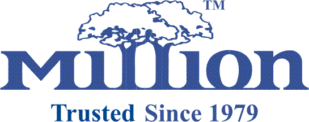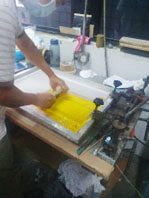Discover Our Guide to Screen Printing on Different Surfaces!
![]() 10 Minutes Read
10 Minutes Read
Introduction
Screen printing, aka silkscreen aka silkscreen printing, dates back at least 100 years. It is said to have first started in China during the Song Dynasty, then adapted by other Asian countries such as Japan, and then introduced to western Europe in the late 18th century. Artists such as Roy Lichtenstein, Andy Warhol, Arthur Okamura and many others have used this method of printing to express their creativity.
Juga dikenali sebagai percetakan serigrafi atau serigraf, kaedah cetakan ini merujuk kepada proses mencipta stensil atau skrin berasingan, dan kemudian menggunakannya untuk menggunakan lapisan dakwat tambahan pada permukaan cetakan. Setiap warna perlu digunakan menggunakan stensil yang berbeza. Untuk mendapatkan imej berbilang warna, pencetak akan menggunakan satu warna pada satu masa dan menggunakan skrin berulang untuk mencapai imej akhir.
The Process
The industrial screen printing process, which is automated, uses advanced inks and materials together with computer technology to conduct mass print. For large volumes of products, it is critical to ensure that the applied layers work perfectly. The commercial screen printing industry uses a wide range of inks for this silkscreen printing method, such as solvent-based inks, water-based inks, plastisol inks, UV-curing inks and special varnishes.
Langkah pertama dalam proses percetakan skrin/Cetak Saring ialah mencipta reka bentuk. Selepas itu, reka bentuk akan dicetak pada filem asetat lutsinar. Langkah seterusnya ialah menggunakan reka bentuk untuk mencipta skrin dan pilih kiraan mesh skrin, iaitu jumlah bilangan gentian dalam satu inci persegi. Kiraan mesh yang anda perlukan bergantung pada reka bentuk. Kiraan jaringan yang lebih tinggi bermakna anda boleh mencetak reka bentuk dalam butiran yang lebih halus.
After the screen mesh has been selected, the silkscreen printer will coat it with a light-reactive emulsion layer such as diazo or dual-cure emulsions. He will then place the transparent acetate film with the design on the screen mesh under a bright ultraviolet UV light, and the emulsion will harden and develop after some time. It is important to use separate screens for multiple different colours.
Selepas skrin terdedah untuk beberapa lama, kawasan yang tidak dilindungi akan mengeras, dan kawasan yang tidak mengeras akan dibilas untuk mendedahkan kesan yang jelas. Skrin akan dikeringkan pada peringkat ini, dan pencetak skrin akan melakukan sentuhan padanya untuk dipadankan dengan reka bentuk asal.
The next step involves the preparation for print, where the material to be printed is placed below the screen. The silkscreen printer will now pour the desired colour ink to the top of the screen, spreading it across with a squeegee or rubber blade evenly to force the ink past the threads of the silk mesh. If any specific areas are left empty, the ink will set there and transfers onto the material, hence printing the design on the product, which will be heat-cured by passing it through a dryer to ensure that it is fade-proof. The mesh can also be washed and then used to create new stencils or screens.
Pencetak skrin industri biasanya menggunakan pelbagai jenis mesin pencetak skrin, tetapi ini adalah jenis yang paling biasa - katil rata, silinder dan berputar. Kebanyakan pencetak komersil moden akan menggunakan pencetak karusel berputar automatik kerana ini membolehkan mereka menggunakan banyak skrin berbeza pada masa yang sama.
Types of Silkscreen Printing
Terdapat enam jenis utama proses percetakan skrin/Cetak Saring, yang akan menghasilkan hasil yang jauh berbeza jadi adalah penting untuk anda memahaminya.
Percetakan Skrin Warna Titik
Spot colour screen printing is the most common silkscreen printing process which uses the ink’s stock colour by printing it through the screen of the mesh. Advantages of this method is that it produces a vibrant spot colour and is a simpler technique as compared to other silkscreen printing methods. This method is often used for printing on garments such as t-shirts and jackets. (See Tips for creating beautiful and effective design that makes the most of spot colors)
Cetakan Skrin Halftone
Warna tunggal dalam kecerunan dicetak dalam percetakan skrin halftone, yang menggunakan satu warna dakwat yang menjadi separuh tona - warna berbeza apabila dilihat dari jauh. Ini adalah kaedah yang menjimatkan kos kerana hanya satu warna digunakan. Proses ini paling kerap digunakan untuk mendapatkan rupa cetakan pelbagai warna tanpa benar-benar mencetaknya.
Pencetakan Skrin Skala Kelabu
Salah satu kaedah percetakan skrin yang paling menjimatkan kos, percetakan skala kelabu melibatkan pencetakan imej berwarna penuh sebagai skala kelabu atau halftone satu warna, dan sering digunakan untuk mencetak reka bentuk hitam dan putih pada fabrik.
Percetakan Skrin Duotone
Similar to the sepia-toned printing technique in photography, duotone screen printing combines two halftones to print the same image with two colours. A black halftone is first printed with black ink, and then a second halftone is printed with colour ink. The final output is sophisticated and refined.
Pencetakan Skrin CMYK
Considered as the most complicated screen printing methods out there, CMYK silkscreen printing uses the four basic colours – cyan (C), magenta (M), yellow (Y) and black (K) to produce the necessary colour tones.
Percetakan Skrin Simulasi
A versatile silkscreen printing method as it can be used for both lighter and darker shades of materials, the simulated silkscreen printing process combines the CMYK silkscreen printing technique with the spot colour silkscreen printing process. Businesses love to use this process, as it can be used to produce photorealistic print details.
Can You Use Silkscreen Printing on Any Surfaces?
A silkscreen print is most commonly used for paper and fabric printing, such as for custom t-shirts like polo t-shirts and hoodies. However, silkscreen printing can also be used for custom designs on other materials and surfaces such as plastic, wood, metal and even glass and ceramics.
Beberapa industri yang menggunakan kaedah Cetak Saring termasuk pengilangan industri, pembina panel dan penyepadu sistem dan kejuruteraan, pemerolehan dan pembinaan. Industri ini sering menggunakan cetakan skrin sutera pada produk pengenalan dan keperluan pelabelan seperti produk plastik, teg perancah, tanda lokasi peralatan kebakaran, tanda trafik, tanda kemudahan dan tindihan grafik seperti panel kawalan.
Other examples of silkscreen print products where silkscreen printing are used include decals, labels and signs, as well as corporate gifts such as clocks and watch faces, plaques and shields, balloons, pens and so on.
Advantages of Using Silkscreen Printing
Silkscreen printing is a popular method of printing in industrial printing as there are many benefits.
Cost-Effective
Silkscreen printing is a fairly simple process and large runs of the same graphics can often be printed together economically, as compared to digital processes. It allows the printer to create a stencil, and then easily reproduce a design from the original image multiple times, as the same stencil can be used. The set-up time only applies in the initial creation of the stencil, and repeated designs can be run quickly and efficiently.
The parts used in the silkscreen method of printing are also easy to replace, and they can withstand wear and tear. Hence, the costs saved can be passed on to the customers.
Durability
Most industrial customers also choose the silkscreen printing method because the final products are more durable and long-lasting, and will not fade or become dull overtime. A silkscreen print lasts longer because of the ink adhesion, where different types of specialty inks are specially formulated to work with individual substrates. Such silkscreen printed inks adhere much more permanently than digital inks to uncoated surfaces. They can withstand more wear and tear too, without losing printed quality.
Excellent Print Quality
A silkscreen print works very well with small text and fine-line illustrations, producing excellent colour prints, especially on colour logo printing and complex designs. Gone are the days when you view sharp and vibrant graphic designs on your computer, only to find them lacking in quality when they are actually manufactured. Such incidents will not happen with silkscreen print products.
Silkscreen printing is also the only printing method that can achieve a texturised, three-dimensional look and feel in your finished design.
Ability to Use Bolder Colours and Designs
The silkscreen printing method allows you to use thicker inks, and hence, your design team can play with bolder colours and designs, which will produce fantastic finishes with far more intense and vibrant colours and sharpness than the CMYK-style dots of solid colours used in digital printing.
Customers looking to increase their brand awareness in signages and other outdoor communications materials can opt for the silk screen printing method, because it will greatly increase your brand visibility.
Serba boleh
Cetak Saring lebih serba boleh berbanding teknik cetakan tradisional lain kerana permukaannya tidak perlu dicetak di bawah tekanan seperti etching, dan juga tidak perlu rata atau satah. Selain itu, anda boleh menggunakan dakwat yang berbeza untuk mengerjakan pelbagai bahan seperti kayu, logam, kaca dan plastik, seperti yang telah kami nyatakan di atas.
Kaedah percetakan skrin juga berfungsi dengan baik dengan bentuk luar biasa seperti bahagian khusus dengan objek besar dan/atau berprofil tinggi dalam sektor pembuatan industri.
Disadvantages of Using Silkscreen Printing
The silkscreen printing technique has more advantages, but there are also some disadvantages. Under certain circumstances, silkscreen printing can be costly. For example, if your quantity is small, it can be costly. The cost can also increase if your designs are very colourful, or need gradients.
Untuk mengetahui lebih lanjut tentang Cetak Saring/pencetakan skrin sutera atau untuk pelbagai jenis perkhidmatan pencetakan skrin sutera kami, hubungi kami untuk sembang!
Baca Lagi
Processes
- Discover Our Guide to Screen Printing on Different Surfaces!
- Maximize Your Digital & Screen Printing Results
- Create Professional Print-Ready Files Easily: Solve Your Printing Woes Now!
- Which printing method offer the better colour fastness, Digital or Screen Print?
Standards
- Get to Know the Weathering Test Standard Test Procedure now!
- What is Corrosion artificial atmosphere-salt spray test?
Umum
- Get your Free Guide: Choose the Right Sign Material
- 8 Tips to Stop Discoloration of Outdoor Surfaces Now!
- The Science behind why red fades faster than white
- Get the best deals by getting directly from the manufacturer
- Save More Money Now: Don’t Get Stuck Paying More for Less
- What you need to know about ink adhesion: why it matters

